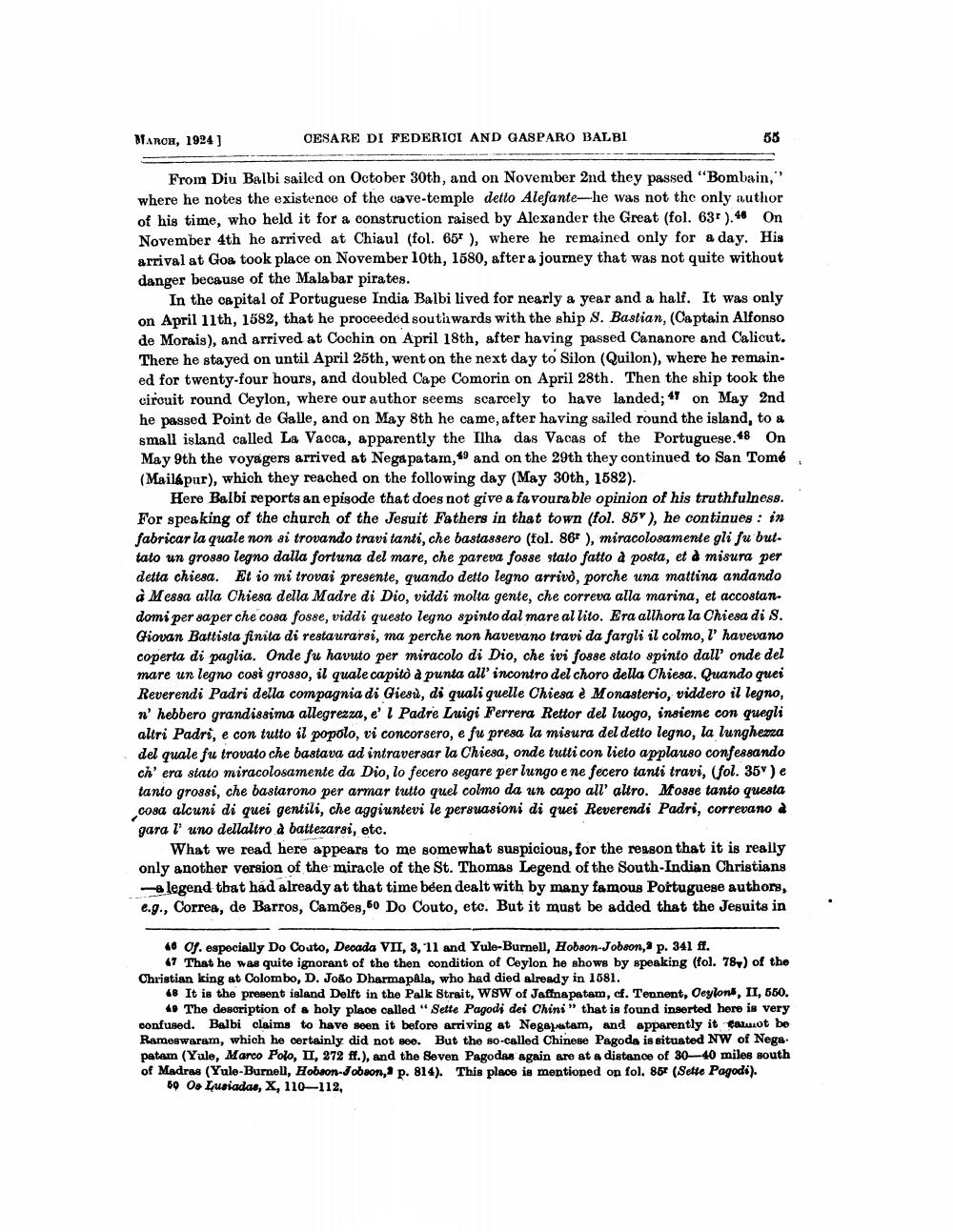________________
MARCH, 1924)
CESARE DI FEDERICI AND GASPARO BALBI
55
From Diu Balbi sailed on October 30th, and on November 2nd they passed "Bombain," where he notes the existence of the cave temple detto Alefante- he was not the only author of his time, who held it for a construction raised by Alexander the Great (fol. 637). 46 On November 4th he arrived at Chiaul (fol. 65), where he remained only for a day. His arrival at Goa took place on November 10th, 1580, after a journey that was not quite without danger because of the Malabar pirates.
In the capital of Portuguese India Balbi lived for nearly a year and a half. It was only on April 11th, 1582, that he proceeded southwards with the ship S. Bastian, (Captain Alfonso de Morais), and arrived at Cochin on April 18th, after having passed Cananore and Calicut. There he stayed on until April 25th, went on the next day to Silon (Quilon), where he remain. ed for twenty-four hours, and doubled Cape Comorin on April 28th. Then the ship took the cirouit round Ceylon, where our author seems scarcely to have landed; 47 on May 2nd he passed Point de Galle, and on May 8th he came, after having sailed round the island, to a small island called La Vacca, apparently the Ilha das Vacas of the Portuguese. 48 On May 9th the voyagers arrived at Nega patam, 49 and on the 29th they continued to San Tomé. (Mailápur), which they reached on the following day (May 30th, 1582).
Here Balbi reports an epigode that does not give a favourable opinion of his truthfulness. For speaking of the church of the Jesuit Fathers in that town (fol. 85), he continues : in fabricar la quale non si trovando travi tanti, che bastassero (fol. 867 ), miracolosamente gli fu but. tato un grosso legno dalla fortuna del mare, che pareva fosse stato fatto a posta, et à misura per detta chiesa. Et io mi trovai presente, quando detto legno arrivo, porche una mattina andando à Messa alla Chiesa della Madre di Dio, viddi molta gente, che correva alla marina, et accostandomi per saper che cosa fosse, viddi questo legno spinto dal mare al lito. Era allhora la Chiesa di S. Giovan Battista finita di restaurarsi, ma perche non havevano travi da fargli il colmo, l' havevano coperta di paglia. Onde fu havuto per miracolo di Dio, che ivi fosse stato spinto dall' onde del mare un legno cosi grosso, il quale capitò a punta all'incontro del choro della Chiesa. Quando quei Reverendi Padri della compagnia di Giesù, di quali quelle Chiesa e Monasterio, viddero il legno, n' hebbero grandissima allegrezza, e' l Padre Luigi Ferrera Rettor del luogo, insieme con quegli altri Padri, e con tutto il popolo, vi concorsero, e fu presa la misura del detto legno, la lunghezza del quale fu trovato che bastava ad intraversar la Chiesa, onde tutti con lieto applauso confessando ch' era stato miracolosamente da Dio, lo fecero segare per lungo e ne fecero tanti travi, (fol. 35 ) e tanto grossi, che bastarono per armar tutto quel colmo da un capo all' altro. Mosse tanto questa cosa alcuni di quei gentili, che aggiuntevi le persuasioni di quei Reverendi Padri, correvano a gara l' uno dellaltro a battezarsi, etc.
What we read here appears to me somewhat suspicious, for the reason that it is really only another version of the miracle of the St. Thomas Legend of the South Indian Christians
a legend that had already at that time been dealt with by many famous Portuguese authors, e.g., Correa, de Barros, Camões, 60 Do Couto, etc. But it must be added that the Jesuits in
46 Of. especially Do Couto, Decada VII, 3, -11 and Yule-Burnell, Hobson-Jobson, p. 341 ff.
47 That he was quite ignorant of the then condition of Ceylon he shows by speaking (fol. 784) of the Christian king at Colombo, D. João Dharmapala, who had died already in 1581.
48 It is the present island Delft in the Palk Strait, WSW of Jaffnapatam, cf. Tennent, Oeylons, II, 650.
49 The description of a holy place called "Sette Pagodi dei Chini" that is found inserted here is very confused. Balbi claims to have seen it before arriving at Negepatam, and apparently it calusot be Rameswaram, which he certainly did not see. But the so-called Chinese Pagoda is situated NW of Nega. patam (Yule, Marco Polo, II, 272 ff.), and the Seven Pagodas again are at a distance of 30—40 miles south of Madras (Yule-Burnell, Hobaon-Jobson, p. 814). This place is mentioned op fol. 867 (Sette Pagoda).
69 Os Lusiadas, X, 110-112,




